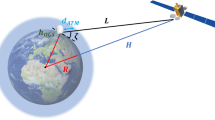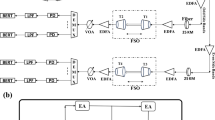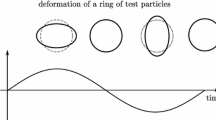Abstract
In this paper, we examine the performance of a free-space optical (FSO) communication system under imperfect Fisher-Snedecor \({\mathcal {F}}\) atmospheric turbulence channels. Taking into consideration the atmospheric turbulence, channel estimation errors, and pointing errors, simple and accurate analytical expressions for the probability density function and cumulative density function under intensity modulation direct detection (IM/DD) and heterodyne detection techniques are derived. Consequently, new analytical expressions for useful performance metrics such as outage probability, average bit error rate, and ergodic capacity are derived. To get more insight into the system diversity gain, asymptotic analytical expressions, in the high signal-to-noise ratio regime, for the outage probability and average BER are obtained. Our analysis is validated by means of numerically and Monte-Carlo simulations under various turbulence conditions and system parameters. The numerical results demonstrate that the derived analytical expressions are very accurate and provide precise evaluations for the proposed performance analyses. In addition, the results show that imperfect CSI seriously affects the FSO communication systems. However, the performance of heterodyne detection outperforms its counterpart the intensity modulation/direct-detection under all scenarios.







Similar content being viewed by others
References
Zhang, J., et al. (2015). Unified performance analysis of mixed radio frequency/free-space optical dual-hop transmission systems. Journal of Lightwave Technology, 33(11), 2286–2293.
Alzenad, M., et al. (2018). FSO-based vertical backhaul/fronthaul framework for 5G+ wireless networks. IEEE Communications Magazine, 56(1), 218–224.
Kaushal, H., & Kaddoum, G. (2017). Optical communication in space: Challenges and mitigation techniques. IEEE Communications Surveys Tutorials, 19(1), 57–96.
Zhu, Xiaoming, & Kahn, J. M. (2002). Free-space optical communication through atmospheric turbulence channels. IEEE Transactions on Communications, 50(8), 1293–1300.
Ansari, I. S., et al. (2016). Performance analysis of free-space optical links over Málaga (\(\cal{M} \)) turbulence channels with pointing errors. IEEE Transactions on Wireless Communications, 15(1), 91–102.
Ansari, I. S., et al. (2015). “Performance analysis of FSO links over unified Gamma-Gamma turbulence channels,” In IEEE VTC-Spring, pp. 1–5.
Al-Habash, A., et al. (2001). Mathematical model for the irradiance probability density function of a laser beam propagating through turbulent media. Optical Engineering, 40(8), 1554–1562.
Farid, A. A., & Hranilovic, S. (2007). Outage capacity optimization for free-space optical links with pointing errors. Journal Lightwave Technology, 25(7), 1702–1710.
Yang, F., et al. (2014). Free-space optical communication with nonzero boresight pointing errors. IEEE Transactions on Communications, 62(2), 713–725.
Peppas, K., et al. (2020). The Fisher-Snedecor \(\cal{F} \)-distribution model for turbulence-induced fading in free-space optical systems. Journal of Lightwave Technology, 38(6), 1286–1295.
Badarneh, O. S., et al. (2020). “Performance analysis of FSO communications over \(\cal{F}\) turbulence channels with pointing errors,” IEEE Commun. Lett., p. 1.
Badarneh, O. S., & Mesleh, R. (2020). Diversity analysis of simultaneous mmwave and free-space-optical transmission over \({\cal{F} }\)-distribution channel models. Journal of Optical Communications and Networking, 12(11), 324–334.
Safi, H., Dargahi, A., & Cheng, J. (2019). “Performance analysis of FSO MIMO multiplexing links with beam wander and nonzero boresight pointing errors,” In Proc. CWIT, pp. 1–6.
Milic, D., Smilic, M., Nikolic, B., Tuba, M., & Spalevic, P. (2019). “Capacity of adaptive free space optical transmission over Malaga turbulence with pointing error using truncated channel inversion,” In Proc. ISDFS, pp. 1–6.
Li, X., Zhao, X., & Zhang, P. (2019). Bit error rate analysis for modulating retro-reflector free space optical communications with adaptive threshold over correlated gamma-gamma fading channels. IEEE Communications Letters, 23(12), 2275–2278.
El Saghir, B. M., & El Mashade, M. B. (2021). Performance of modulating retro-reflector FSO communication systems with nonzero boresight pointing error. IEEE Communications Letters, 25(6), 1945–1948.
Zhao, H., & Alouini, M.-S. (2019). On the performance of quantum key distribution FSO systems under a generalized pointing error model. IEEE Communications Letters, 23(10), 1801–1805.
Ibrahim, A. A., et al. (2020). Performance analysis of free space optical communication systems over imprecise Málaga fading channels. Optics Communications, 457, 124694.
Feng, J., & Zhao, X. (2017). Performance analysis of OOK-based FSO systems in gamma-gamma turbulence with imprecise channel models. Optics Communications, 402, 340–348.
Suraweera, H. A., et al. (2010). Capacity limits and performance analysis of cognitive radio with imperfect channel knowledge. IEEE Transactions on Vehicular Technology, 59(4), 1811–1822.
Chen, X., & Yuen, C. (2016). On interference alignment with imperfect CSI: Characterizations of outage probability, ergodic rate and SER. IEEE Transactions on Vehicular Technology, 65(1), 47–58.
Prudnikov, A. P., et al. (1990). Integrals, and Series: More Special Functions (Vol. 3). New York: Gordon & Breach Sci. Publ.
Gradshteyn, I. S., & Ryzhik, I. M. (2007). Table of Integrals, Series, and Products (7th ed.). California: Academic Press.
W. R. Inc. Hypergeometric functions. Visited on 28/02/2021. [Online]. Available: http://functions.wolfram.com/07.34.06.0006.01.
Acknowledgements
This work is supported by the Deanship of scientific research at the German Jordanian University under grant number SEEIT01/2019.
Funding
The authors have not disclosed any funding.
Author information
Authors and Affiliations
Corresponding author
Ethics declarations
Conflict of interest
The authors have not disclosed any competing interests.
Additional information
Publisher's Note
Springer Nature remains neutral with regard to jurisdictional claims in published maps and institutional affiliations.
APPENDIX
APPENDIX
Proof of Lemma 1
To find the PDF of \(\gamma \), we need first to find the PDF of \(\hat{h}=h+\epsilon \). To this end, the PDF of \(\hat{h}\) can be found via
where \(x = \rho h\) and \(y =\sqrt{1-\rho ^2}\epsilon \). Using (3), (4) and after performing transformation of RVs, (47) can be rewritten as (48), at the top of the next page. Using [23, Eq. (1.211.1)] and [22, Eq. (8.4.3.1)], the integral in (48) can be rewritten as in (49), which can be solved with the help of [22, Eq. (2.24.1.1)] and after some algebraic manipulations as in (10).
The CDF of \(\hat{h}\) can be obtained by integrating (10) along with using [22, Eq. (2.24.2.2)] and [22, Eq. (8.4.16.1)], it can be expressed as in (11). This ends the proof of Lemma. 1. \(\square \)
Proof of Lemma 2
The proof of the turbulence misalignment scenario is similar to that in turbulence scenario only. Thus, using (3), (7), and after performing transformation of RVs, (47) can be rewritten as in (50). Using [23, Eq. (1.211.1)] and [22, Eq. (8.4.3.1)], the integral in (50) can be rewritten as in (51), which can be solved with the help of [22, Eq. (2.24.1.1)] and after some algebraic manipulations as in (14). Thereafter, the CDF of \(\gamma \) can be obtained by integrating (14), using [22, Eq. (2.24.2.2)], and [22, Eq. (8.4.16.1)]. This completes the proof of Lemma. 2. \(\square \)
Proof of Lemma 3
Based on (1), the received electrical SNR and the average electrical SNR for the FSO systems under consideration can be respectively expressed as \(\gamma =(\frac{\epsilon \omega }{N_o})^r\) and \(\mu _r=\frac{\epsilon ^r E^r[\omega ]}{N_o}\), where \(N_o\) refers to the Gaussian noise power spectral density, v characterizes the detection type. Note that \(r=1\) for heterodyne detection while \(r=2\) for IM/DD. Here, \(E[\cdot ]\) refers to the expectation operator, where the n-th moment is defined as
Substituting (10) into (52), using [23, Eq. (3.326.2)] and after some mathematical manipulation, the n-th moment in (18) is obtained. \(\square \)
Proof of Lemma 4
With the aid of (10), (11), and (18), the PDF and CDF of the received SNRs, for both detection techniques, can be respectively obtained as in (19) and (20). \(\square \)
Proof of Lemma 5
Substituting (14) into (52), then using [23, Eq. (3.326.2)] and after some mathematical manipulation, the n-th moment of the \({\mathcal {F}}\) turbulence channel with imperfect CSI and in the presence of pointing errors can be obtained as in (21). \(\square \)
Proof of Lemma 6
With the help of (14), (15), and (21), the PDF and CDF of the received SNRs for both detection techniques under the \({\mathcal {F}}\) turbulence channel model with imperfect CSI and in the presence of pointing errors can be respectively obtained as in (22) and (23). \(\square \)
Rights and permissions
Springer Nature or its licensor (e.g. a society or other partner) holds exclusive rights to this article under a publishing agreement with the author(s) or other rightsholder(s); author self-archiving of the accepted manuscript version of this article is solely governed by the terms of such publishing agreement and applicable law.
About this article
Cite this article
Badarneh, O.S., Derbas, R., Almehmadi, F.S. et al. Free-space optical communications over imperfect \({\mathcal {F}}\) turbulence channels with pointing errors. Telecommun Syst 83, 41–50 (2023). https://doi.org/10.1007/s11235-023-01006-4
Accepted:
Published:
Issue Date:
DOI: https://doi.org/10.1007/s11235-023-01006-4




